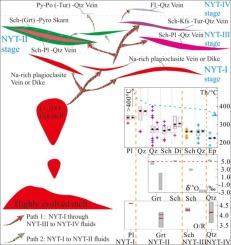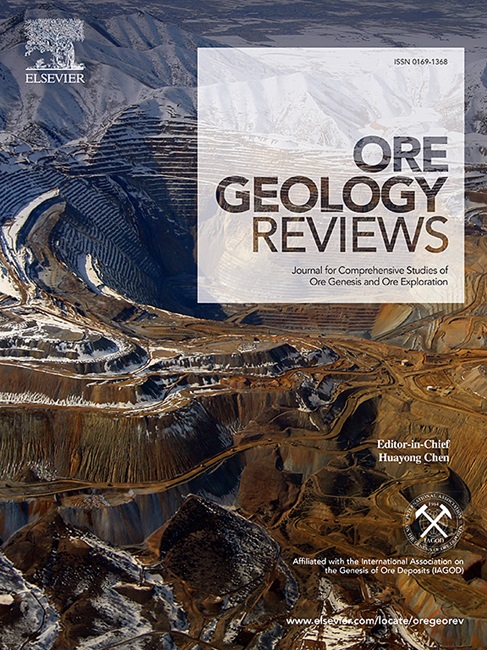Discrimination of two diverse fluid evolutions from the Nanyangtian scheelite deposit, southeastern Yunnan: Evidences from fluid inclusions and mineral geochemistry
IF 3.6
2区 地球科学
Q1 GEOLOGY
引用次数: 0
Abstract
The Nanyangtian scheelite deposit is located in the Nanwenhe-Song Chay dome (NSCD), southeastern Yunnan. This deposit has undergone four metallogenic stages and is characterized by several kilometers of bedded scheelite-bearing skarn (NYT-II stage), feldspar-bearing quartz veins (NYT-III stage), and sulfides (NYT-IV stage) in the Neoproterozoic schist and gneiss, all of which exhibit similar fold deformations. Throughout the stages, Th and salinity of fluids gradually decrease, weakly and positively correlating, representing a slow cooling process. NYT-I fluids (F-, H2O-rich and high T, p), as indicated by the plagioclase within feldspar-bearing quartz veins, may have directly evolved from a highly fractional residual melt or a salt-rich aqueous melt, signifying the magmatic-hydrothermal transition. From NYT-II to NYT-III fluids, a wider variation of δ18OH2O (−2.4 ∼ 5.1 ‰) to a narrow range of δ18OH2O (2.8 ∼ 5.1 ‰), and a narrow δ34S range (5.18 ‰ ∼ 8.62 ‰) also indicates that fluids may evolve from the relatively oxidized granitic magma. Furthermore, NYT-I fluids could extend throughout the entire fluid evolution, culminating in two diverse paths: one is a much purer magmatic water towards the NYT-III and NYT-IV fluids, and the other is a more meteoric water-dominated towards the NYT-II fluids. A lower water/rock ratio (W/R) existed in the NYT-II stage, leading to the formation of moderately oxidized Tungsten (W)-skarns and scheelites through the NYT-I salt-rich aqueous melts or their reactions with wall rocks in a stable environment. W/R ratios increased in the NYT-III stage, resulting in the formation of NYT-III feldspar-bearing quartz veins with CO2 generation and alkalinity enhancement. As oxidation diminished, fluids gradually evolved into the NYT-IV fluids, forming sulfides.

云南东南部南阳田白钨矿床两种不同流体演化的鉴别:流体包裹体和矿物地球化学证据
南阳田白钨矿床位于云南东南部的南汶河-松茶穹窿(NSCD)。该矿床经历了四个成矿期,其特征是在新新生代片岩和片麻岩中形成了数公里长的含白钨矿的矽卡岩层(NYT-II期)、含长石的石英脉(NYT-III期)和硫化物(NYT-IV期),所有这些岩层都表现出类似的褶皱变形。在各阶段中,流体的钍含量和盐度逐渐降低,呈弱正相关,代表了一个缓慢的冷却过程。NYT-Ⅰ流体(富含F、H2O和高T、p),由含长石石英脉中的斜长石可知,可能是由高分馏残余熔体或富含盐分的水溶液熔体直接演化而来,标志着岩浆-热液转变。从NYT-II流体到NYT-III流体,δ18OH2O的变化范围由大(-2.4 ∼ 5.1 ‰)到δ18OH2O的狭窄范围(2.8 ∼ 5.1 ‰),以及δ34S的狭窄范围(5.18 ‰ ∼ 8.62 ‰)也表明流体可能是从相对氧化的花岗岩岩浆中演化而来。此外,NYT-I流体可能贯穿整个流体演化过程,最终形成两种不同的流体路径:一种是更纯净的岩浆水,流向NYT-III和NYT-IV流体;另一种是以陨石水为主的流体,流向NYT-II流体。在NYT-II阶段,水/岩石比(W/R)较低,通过NYT-I富含盐分的水熔体或在稳定环境中与壁岩的反应,形成了中等氧化程度的钨(W)矽卡岩和白钨矿。在NYT-III阶段,W/R比率增加,形成了NYT-III含长石石英脉,并产生二氧化碳,碱度增强。随着氧化作用的减弱,流体逐渐演变为 NYT-IV 流体,形成硫化物。
本文章由计算机程序翻译,如有差异,请以英文原文为准。
求助全文
约1分钟内获得全文
求助全文
来源期刊

Ore Geology Reviews
地学-地质学
CiteScore
6.50
自引率
27.30%
发文量
546
审稿时长
22.9 weeks
期刊介绍:
Ore Geology Reviews aims to familiarize all earth scientists with recent advances in a number of interconnected disciplines related to the study of, and search for, ore deposits. The reviews range from brief to longer contributions, but the journal preferentially publishes manuscripts that fill the niche between the commonly shorter journal articles and the comprehensive book coverages, and thus has a special appeal to many authors and readers.
 求助内容:
求助内容: 应助结果提醒方式:
应助结果提醒方式:


